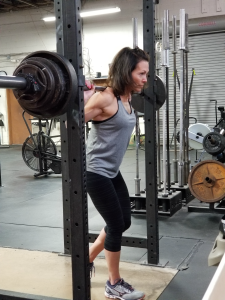Delayed onset muscle soreness, or DOMS, is pain and/or stiffness in your muscles 24 to 72 hours after a training session. The pain is due to microscopic tears in your muscle fibers caused by eccentric exercise, or the portion of the movement where your muscle is lengthening while under tension—like the lowering down portion of a biceps curl, and the descent of a squat or pull-up. These little muscle tears, when given time to heal, leave your muscle fibers a bit stronger than they were before. With repeated exposure to exercise, your muscles adapt to that stimulus and you are less likely to experience soreness.
Adaptation is important because whatever you’re into these days for exercise you don’t want wake up the few days post training feeling like you got run over by a truck. Soreness after every single training session is important information for you. Contrary to some popular schools of thought that dictate going all out in every training session, frequent soreness doesn’t mean you’re doing it right. It’s a strongly worded message from your body telling you you’re not adapting. It means you aren’t getting stronger, faster, or fitter!
Over time with exercise or training, you want what once felt very hard and left your muscles a bit weepy in the days after to feel a bit easier. When what you’re doing feels easier, you can keep nudging your way forward with all sorts of ways to improve such as :
- Lifting heavier weights
- Finishing your workout faster
- Completing more reps and sets
- Increasing your ROM
- Improving your exercise form
- Increasing your training frequency
Think of it like this – you’re not actually getting stronger in the gym. You’re actually getting stronger in recovery when you give your muscles time heal.
If you’re experiencing frequent DOMS, then two things may be going on:
- You’re pushing too hard, too often, in your training sessions.
- You’re pushing too hard, too infrequently, in your training sessions.
Enter strategies for DOMS. These are non-invasive methods used by many and some work better than others, depending on each individual.
1. Epsom Salt Baths
In water, epsom salts break down into magnesium and sulfate and the idea is that these minerals are absorbed into your skin, aiding in easing discomfort in stiff or sore muscles and joints. How effective they are is dependent on the individual, but for some they work like a dream. That may be due, however, to the amount of salt dumped in!
2. Active Recovery
When your muscles are sore you’re probably going to want to rest, but it is advised against complete and total avoidance of activity. Even though jumping right into a big workout the next day might not be in the cards, gentle movements like walking, restorative yoga, and even swimming are a good ideas. These activities will help keep your muscles warm and flexible, and help ease the feeling soreness while your muscles heal.
3. Foam Roll
Empirical evidence on the efficacy of foam rolling is thin. Studies that show the most positive effects are when the participants spend 90 seconds or more on a sore area. But the rewards don’t seem to come from the original claim of foam rolling: that doing so smoothes your connective tissues to break down tightness or knots. Instead, its main benefit seems to be in activating the pressure receptors in your skin and relaxation of your central nervous system. In other words, for some, it just feels good.
Muscle soreness can add insult to injury by making us feel stressed out. Pain can be exhausting and we don’t have time for that! If foam rolling feels good, then do it!
4. Drink Tart Cherry Juice To Avoid DOMS
Tart cherry juice might help reduce the swelling that occurs when your muscles are damaged, which can help you recover faster and with less pain. Drink 8 oz. of tart cherry juice (straight up) in heavy training sessions, and not just for the antioxidants. The liquid carbs provide a nice boost of energy too!
5. Water, Water, Water…All Day, Every Day
Ugggghhh, how boring is this??? You’ve heard this before but if you aren’t drinking your bodyweight in ounces of water every day then maybe this is the day where the importance will sink in and you will start. Your muscles need water to aid in protein synthesis (muscle repair). And if they are dehydrated, then you are at a disadvantage before having stepped foot in the gym.
Don’t like the taste of water? Then sweeten it with fruit, mint, or cucumber, or grab a zero calorie sweetener.
I hope this works when you need it to! Do you have a “go-to” DOMS recovery strategy? Message me if you don’t and let’s me help you!


